ARTIST MONOGRAPHS
|
|
STATUS: Forthcoming | 4/29/2025 This title is not yet published in the U.S. To pre-order or receive notice when the book is available, please email orders @ artbook.com |
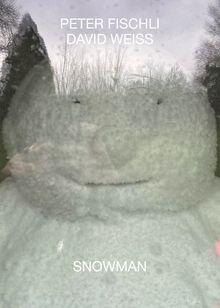 Peter Fischli & David Weiss: Snowman
Peter Fischli & David Weiss: Snowman
Published by Walther König, Köln.
Text by Cara Manes.
In 1987, Peter Fischli (born 1952) and David Weiss (1946–2012) created Snowman, a permanently frozen snowman sculpture installed outside (and preserved by) the Römerbrücke power station in Saarbrücken, Germany. In 2017, Fischli was commissioned by the San Francisco Museum of Modern Art to remake the work. His Snowman consisted of three copper spheres contained in a large freezer. As frost accumulated on the spheres, the snowman grew in size, eventually requiring defrosting, his smile redrawn daily to preserve his expression.
This artist’s book tells the story of the Snowman from 1987 to today, chronicling its iterations in a photo essay. It also illustrates the transformation of the snowman’s cultural meanings since the 18th century, from “bogeyman” to loveable friend, and shows how the generation of electricity has changed in the last 35 years, from thermal power station to solar energy.
PUBLISHER
Walther König, Köln
BOOK FORMAT
Flexi, 6 x 8.25 in. / 176 pgs / 161 color.
PUBLISHING STATUS
Pub Date 1/10/2023
Active
DISTRIBUTION
D.A.P. Exclusive
Catalog: SPRING 2023 p. 30
PRODUCT DETAILS
ISBN 9783753302508 FLAT40
List Price: $30.00 CAD $42.00
AVAILABILITY
In stock
in stock $30.00 Free Shipping UPS GROUND IN THE CONTINENTAL U.S. |
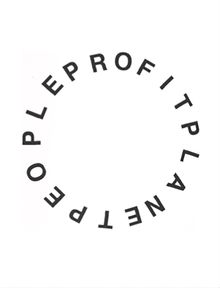 Peter Fischli: Planet People Profit
Peter Fischli: Planet People Profit
Published by Walther Koenig.
Text by Peter Fischli.
In his latest solo project, Peter Fischli (born 1952), formerly of artist duo Fischli/Weiss, has created an image-based artist’s book depicting 296 book covers in loose topic sequence, imitating the kind of classification principles found in a bookshop or library—self-help, specialist and reference books. Each of the books included revolves around topics of finance and the economy, management, banking, accounting, maximizing profit, improving performance and other related themes. The title of the book comes from John Elkington’s 1994 “triple bottom line” concept, a theory which shifts the measure of a company’s success from financial to holistic. In this vision of corporate success, a company considers not only their financial bottom line, but also accounts for the human and ecological costs of running a productive business.
PUBLISHER
Walther Koenig
BOOK FORMAT
Flexi, 7.25 x 9.5 in. / 348 pgs / 296 color.
PUBLISHING STATUS
Pub Date 11/9/2021
Active
DISTRIBUTION
D.A.P. Exclusive
Catalog: SPRING 2022 p. 34
PRODUCT DETAILS
ISBN 9783753300191 FLAT40
List Price: $69.95 CAD $95.95
AVAILABILITY
In stock
in stock $69.95 Free Shipping UPS GROUND IN THE CONTINENTAL U.S. |
 Peter Fischli and David Weiss: Flowers and Mushrooms
Peter Fischli and David Weiss: Flowers and Mushrooms
Published by Walther König, Köln.
PUBLISHER
Walther König, Köln
BOOK FORMAT
Paperback, 7.75 x 10 in. / 160 pgs / 40 color.
PUBLISHING STATUS
Pub Date 6/14/2016
Out of print
DISTRIBUTION
D.A.P. Exclusive
Catalog: FALL 2016 p. 96
PRODUCT DETAILS
ISBN 9783863358747 SDNR40
List Price: $39.95 CAD $53.95
AVAILABILITY
Not available
STATUS: Out of print | 00/00/00 For assistance locating a copy, please see our list of recommended out of print specialists |
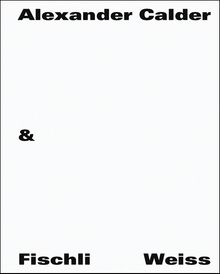 Alexander Calder & Fischli / Weiss
Alexander Calder & Fischli / Weiss
Published by Hatje Cantz.
Text by Theodora Vischer, et al.
At first glance, both positions could hardly be more different; later, however, they proved to be two sides of the same coin, the result of different perspectives on the same theme at different times. This elaborately designed, richly illustrated catalogue with accompanying essays provides insight into both oeuvres.
PUBLISHER
Hatje Cantz
BOOK FORMAT
Hardcover, 9.75 x 12 in. / 272 pgs / 180 color.
PUBLISHING STATUS
Pub Date 8/23/2016
Active
DISTRIBUTION
D.A.P. Exclusive
Catalog: FALL 2016 p. 105
PRODUCT DETAILS
ISBN 9783775741279 TRADE
List Price: $85.00 CAD $112.50
AVAILABILITY
Out of stock
STATUS: Out of stock Temporarily out of stock pending additional inventory. |
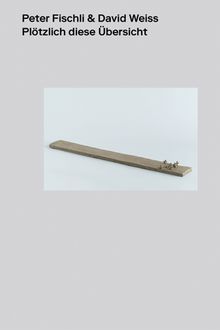 Peter Fischli & David Weiss: Suddenly This Overview
Peter Fischli & David Weiss: Suddenly This Overview
Published by Laurenz Foundation, Schaulager.
Introduction by Peter Fischli.
PUBLISHER
Laurenz Foundation, Schaulager
BOOK FORMAT
Hardcover, 7 x 10.5 in. / 392 pgs / 900 color.
PUBLISHING STATUS
Pub Date 8/25/2015
Active
DISTRIBUTION
D.A.P. Exclusive
Catalog: FALL 2015 p. 122
PRODUCT DETAILS
ISBN 9783906315034 TRADE
List Price: $65.00 CAD $87.00
AVAILABILITY
Out of stock
STATUS: Out of stock Temporarily out of stock pending additional inventory. |
 Fischli & Weiss: Rock on Top of Another Rock
Fischli & Weiss: Rock on Top of Another Rock
Valdresflya & Kensington Gardens
Published by Forlaget Press.
Edited by Line Ulekleiv. Foreword by Jan Andresen, Julia Peyton-Jones, Hans Ulrich Obrist. Text by Pernille Albrethsen, John Kelsey, Patrick Frey.
PUBLISHER
Forlaget Press
BOOK FORMAT
Hardcover, 6.25 x 8.75 in. / 176 pgs / 60 color.
PUBLISHING STATUS
Pub Date 2/28/2014
Active
DISTRIBUTION
D.A.P. Exclusive
Catalog: FALL 2013 p. 125
PRODUCT DETAILS
ISBN 9788275475426 TRADE
List Price: $45.00 CAD $60.00 GBP £40.00
AVAILABILITY
In stock
in stock $45.00 Free Shipping UPS GROUND IN THE CONTINENTAL U.S. |
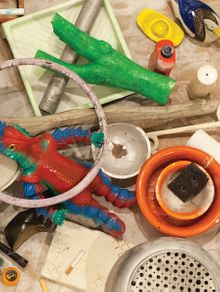 Peter Fischli David Weiss
Peter Fischli David Weiss
Published by Glenstone.
Edited by Emily Wei Rales, Ali Nemerov. Foreword by Emily Wei Rales, Mitchell P. Rales. Text by Boris Groys, Mark Godfrey. Interview by Brian O'Doherty, Hans Ulrich Obrist.
PUBLISHER
Glenstone
BOOK FORMAT
Hardcover, 8.25 x 11 in. / 256 pgs / 1660 color.
PUBLISHING STATUS
Pub Date 2/28/2014
Active
DISTRIBUTION
D.A.P. Exclusive
Catalog: SPRING 2014 p. 108
PRODUCT DETAILS
ISBN 9780980108637 TRADE
List Price: $65.00 CAD $87.00
AVAILABILITY
Out of stock
STATUS: Out of stock Temporarily out of stock pending additional inventory. |
 Peter Fischli & David Weiss: Polyurethane Sculptures
Peter Fischli & David Weiss: Polyurethane Sculptures
Published by Walther König, Köln.
PUBLISHER
Walther König, Köln
BOOK FORMAT
Paperback, 6 x 8 in. / 144 pgs / 146 color.
PUBLISHING STATUS
Pub Date 6/30/2014
Active
DISTRIBUTION
D.A.P. Exclusive
Catalog: FALL 2014 p. 134
PRODUCT DETAILS
ISBN 9783863354992 FLAT40
List Price: $39.95 CAD $53.95
AVAILABILITY
Out of stock
STATUS: Out of stock Temporarily out of stock pending additional inventory. |
 Peter Fischli & David Weiss: Sonne, Mond und Sterne
Peter Fischli & David Weiss: Sonne, Mond und Sterne
Published by JRP|Ringier.
Edited by Beatrix Ruf.
PUBLISHER
JRP|Ringier
BOOK FORMAT
Paperback, 10 x 12.5 in. / 800 pgs / 800 color.
PUBLISHING STATUS
Pub Date 8/1/2008
Active
DISTRIBUTION
D.A.P. Exclusive
Catalog: FALL 2008 p. 82
PRODUCT DETAILS
ISBN 9783905829419 TRADE
List Price: $69.00 CAD $92.50 GBP £32.00
AVAILABILITY
Out of stock
STATUS: Out of stock Temporarily out of stock pending additional inventory. |
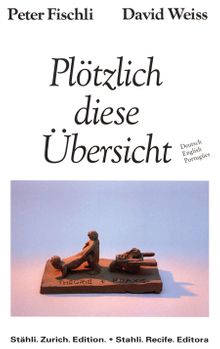 Peter Fischli & David Weiss: Plötzlich diese Übersicht
Peter Fischli & David Weiss: Plötzlich diese Übersicht
Published by Walther König, Köln.
PUBLISHER
Walther König, Köln
BOOK FORMAT
Paperback, 4.5 x 6.75 in. / 180 pgs / 173 bw.
PUBLISHING STATUS
Pub Date 9/1/2008
Out of print
DISTRIBUTION
D.A.P. Exclusive
Catalog: SPRING 2009 p. 86
PRODUCT DETAILS
ISBN 9783906135410 TRADE
List Price: $58.00 CAD $77.50
AVAILABILITY
Not available
STATUS: Out of print | 00/00/00 For assistance locating a copy, please see our list of recommended out of print specialists |
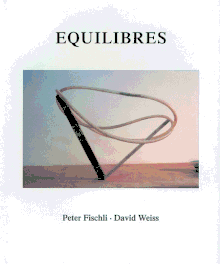 Peter Fischli & David Weiss: Equilibres
Peter Fischli & David Weiss: Equilibres
Published by Walther König, Köln.
PUBLISHER
Walther König, Köln
BOOK FORMAT
Hardcover, 7.75 x 9.5 in. / 168 pgs / 150 color / 50 bw.
PUBLISHING STATUS
Pub Date 3/1/2007
Out of print
DISTRIBUTION
D.A.P. Exclusive
Catalog: SPRING 2007 p. 153
PRODUCT DETAILS
ISBN 9783865601506 TRADE
List Price: $54.00 CAD $72.50
AVAILABILITY
Not available
STATUS: Out of print | 00/00/00 For assistance locating a copy, please see our list of recommended out of print specialists |
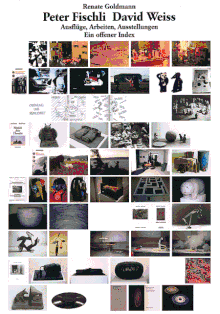 Peter Fischli & David Weiss: Ausflüge, Arbeiten, Austellungen
Peter Fischli & David Weiss: Ausflüge, Arbeiten, Austellungen
Ein Offener Index
Published by Walther König, Köln.
Interview by Renate Goldman.
PUBLISHER
Walther König, Köln
BOOK FORMAT
Paperback, 8.5 x 11.75 in. / 646 pgs / 639 color.
PUBLISHING STATUS
Pub Date 3/1/2007
Out of print
DISTRIBUTION
D.A.P. Exclusive
Catalog: SPRING 2007 p. 152
PRODUCT DETAILS
ISBN 9783865600196 TRADE
List Price: $72.00 CAD $85.00
AVAILABILITY
Not available
STATUS: Out of print | 12/11/2007 For assistance locating a copy, please see our list of recommended out of print specialists |
 Peter Fischli & David Weiss: Will Happiness Find Me?
Peter Fischli & David Weiss: Will Happiness Find Me?
Published by Walther König, Köln.
Artwork by Peter Fischli, David Weiss.
PUBLISHER
Walther König, Köln
BOOK FORMAT
Paperback, 4 x 5.75 in. / 168 pgs / illustrated throughout.
PUBLISHING STATUS
Pub Date 8/2/2003
Out of print
DISTRIBUTION
D.A.P. Exclusive
Catalog: SPRING 2004
PRODUCT DETAILS
ISBN 9783883757230 SDNR30
List Price: $20.00 CAD $27.95
AVAILABILITY
Not available
STATUS: Out of print | 00/00/00 For assistance locating a copy, please see our list of recommended out of print specialists |
Peter Fischli And David Weiss: Visible World
Published by Walther König, Köln.
Photographs by Peter Fischli, David Weiss.
PUBLISHER
Walther König, Köln
BOOK FORMAT
Paperback, 8.25 x 10.75 in. / 360 pgs / 2800 color / 51 bw
PUBLISHING STATUS
Pub Date 2/2/2003
Out of print
DISTRIBUTION
D.A.P. Exclusive
Catalog: SPRING 2003
PRODUCT DETAILS
ISBN 9781880146255 SDNR30
List Price: $55.00 CAD $65.00
AVAILABILITY
Not available
STATUS: Out of print | 00/00/00 For assistance locating a copy, please see our list of recommended out of print specialists |
Fischli/Weiss: Garden
Published by Oktagon.
Photographs by Peter Fischli, David Weiss. Edited by Florian Matzner.
PUBLISHER
Oktagon
BOOK FORMAT
Paperback, 5 x 6.7 in. / 88 pgs / 83 color
PUBLISHING STATUS
Pub Date 9/2/1998
No longer our product
DISTRIBUTION
D.A.P. Exclusive
Catalog: FALL 1998
PRODUCT DETAILS
ISBN 9783896110435 SDNR30
List Price: $45.00 CAD $55.00
AVAILABILITY

